Abstract
Estrogens are defined by their ability to induce the proliferation of cells of the female genital tract. The wide chemical diversity of estrogenic compounds precludes an accurate prediction of estrogenic activity on the basis of chemical structure. Rodent bioassays are not suited for the large-scale screening of chemicals before their release into the environment because of their cost, complexity, and ethical concerns. The E-SCREEN assay was developed to assess the estrogenicity of environmental chemicals using the proliferative effect of estrogens on their target cells as an end point. This quantitative assay compares the cell number achieved by similar inocula of MCF-7 cells in the absence of estrogens (negative control) and in the presence of 17 beta-estradiol (positive control) and a range of concentrations of chemicals suspected to be estrogenic. Among the compounds tested, several "new" estrogens were found; alkylphenols, phthalates, some PCB congeners and hydroxylated PCBs, and the insecticides dieldrin, endosulfan, and toxaphene were estrogenic by the E-SCREEN assay. In addition, these compounds competed with estradiol for binding to the estrogen receptor and increased the levels of progesterone receptor and pS2 in MCF-7 cells, as expected from estrogen mimics. Recombinant human growth factors (bFGF, EGF, IGF-1) and insulin did not increase in cell yields. The aims of the work summarized in this paper were a) to validate the E-SCREEN assay; b) to screen a variety of chemicals present in the environment to identify those that may be causing reproductive effects in wildlife and humans; c) to assess whether environmental estrogens may act cumulatively; and finally d) to discuss the reliability of this and other assays to screen chemicals for their estrogenicity before they are released into the environment.
Full text
PDF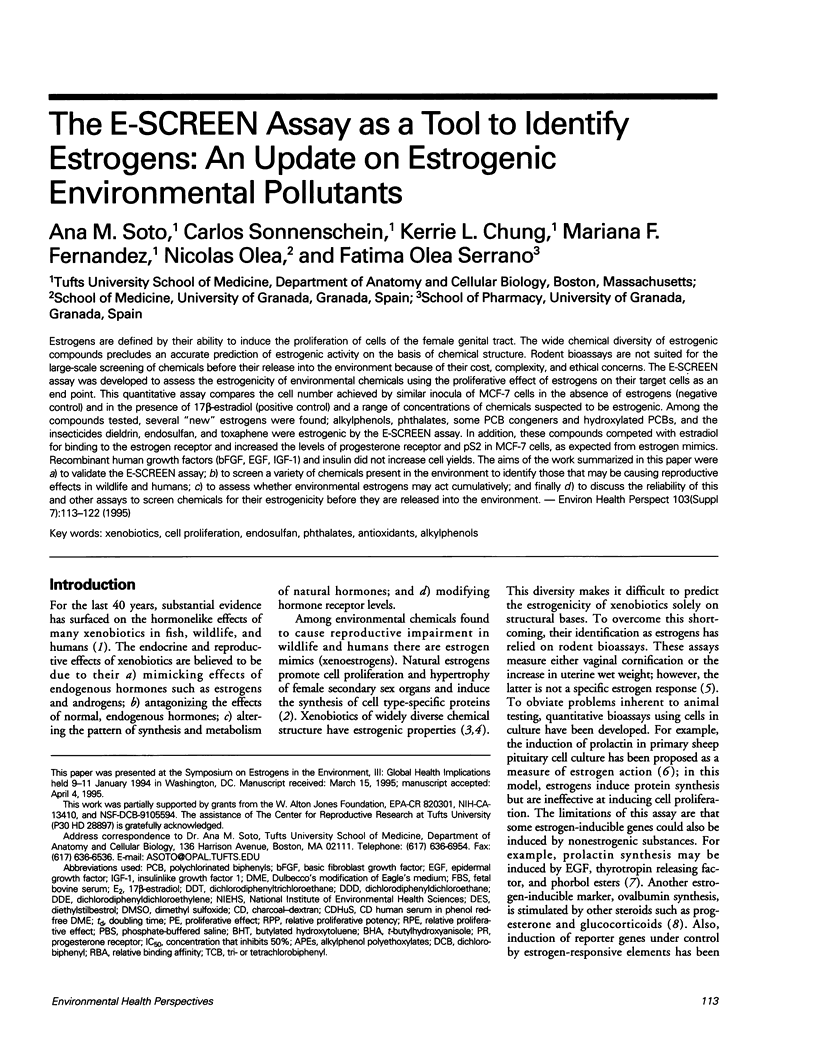
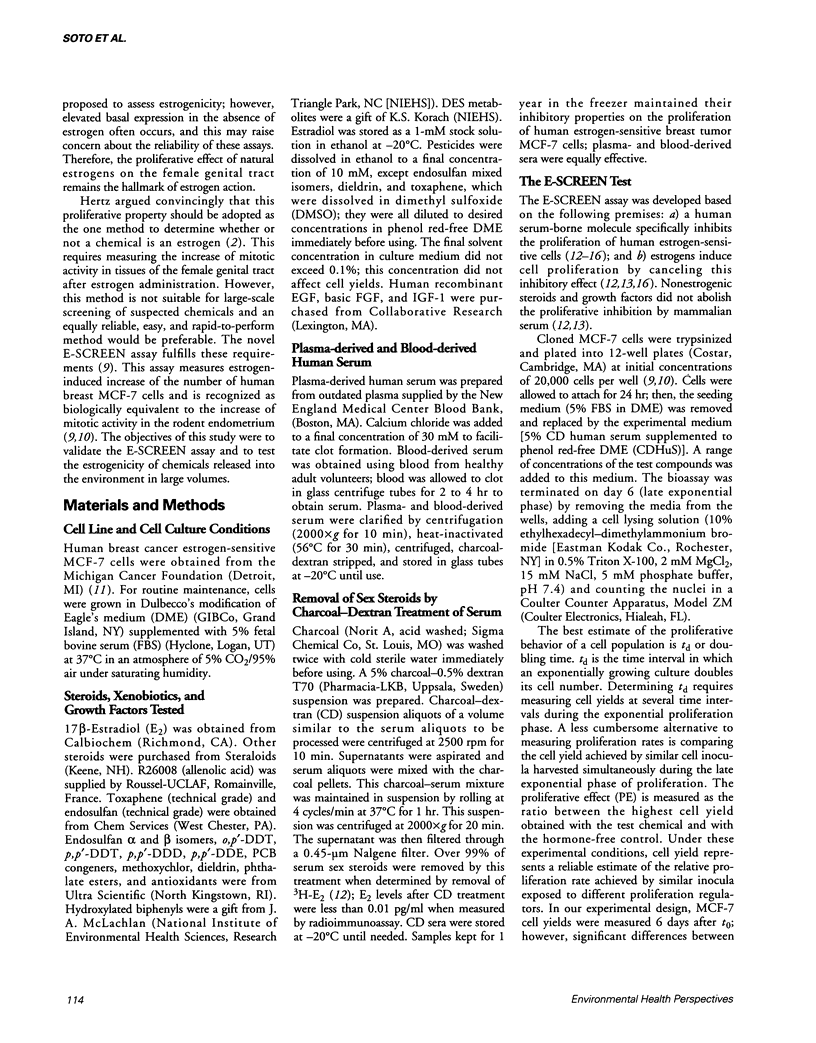

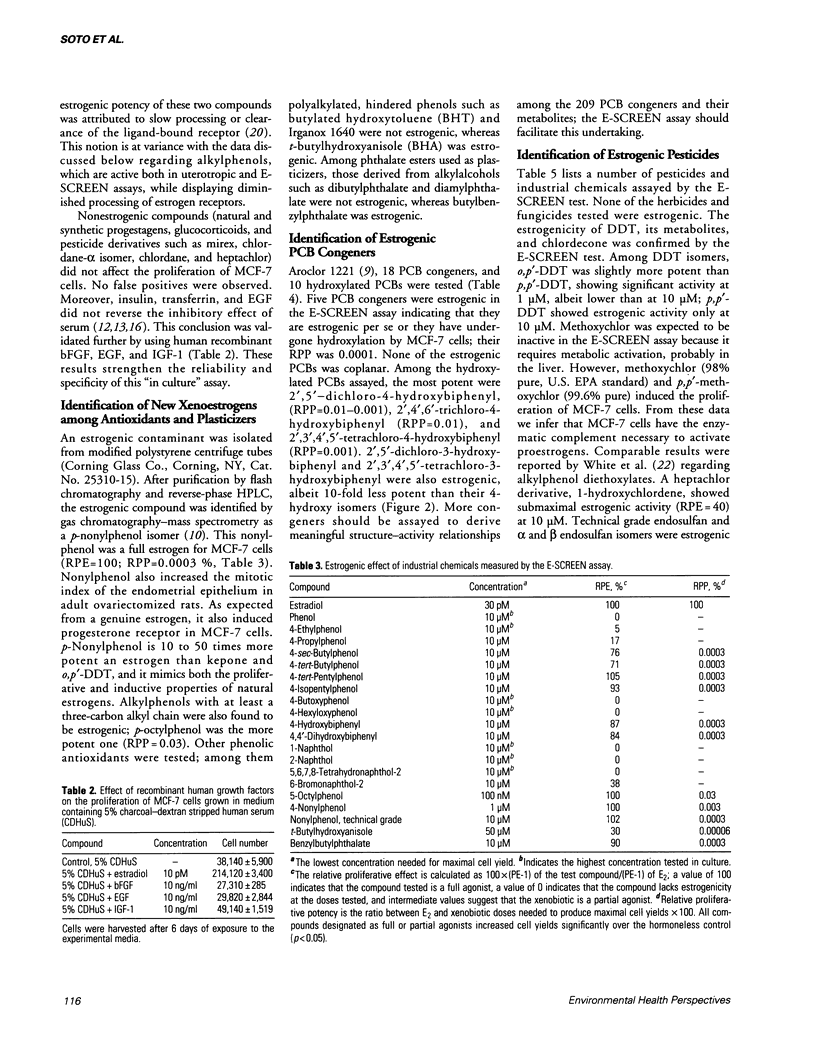
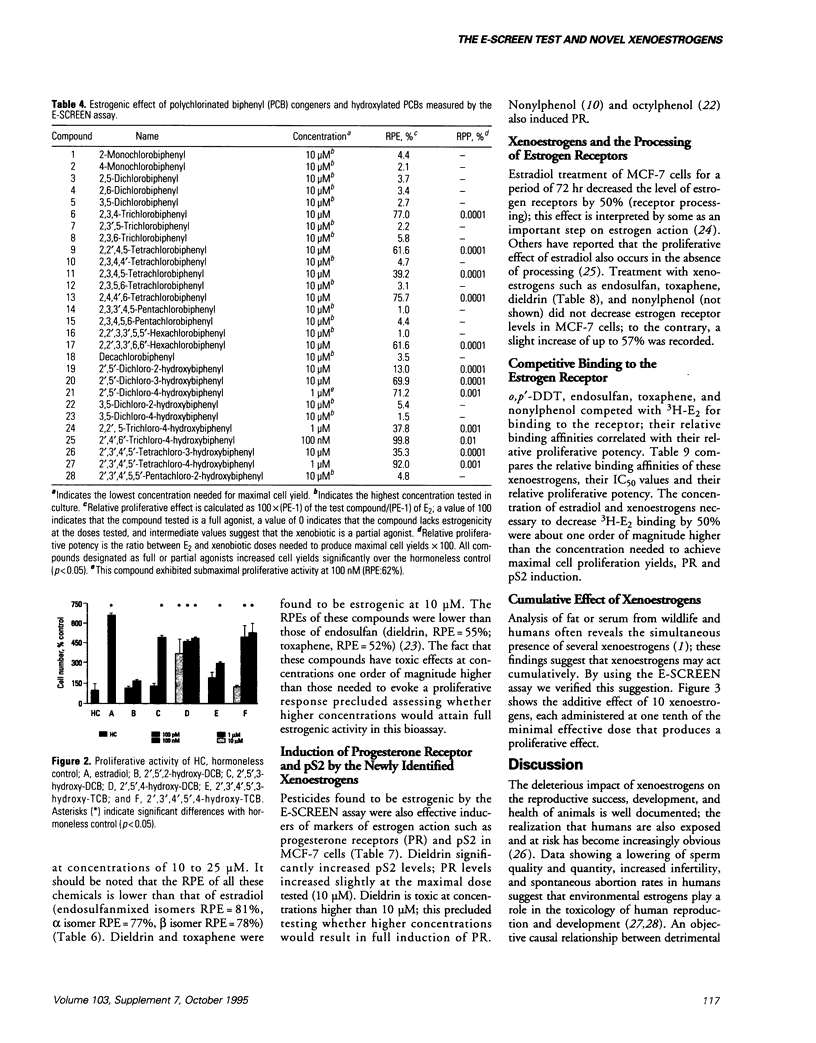

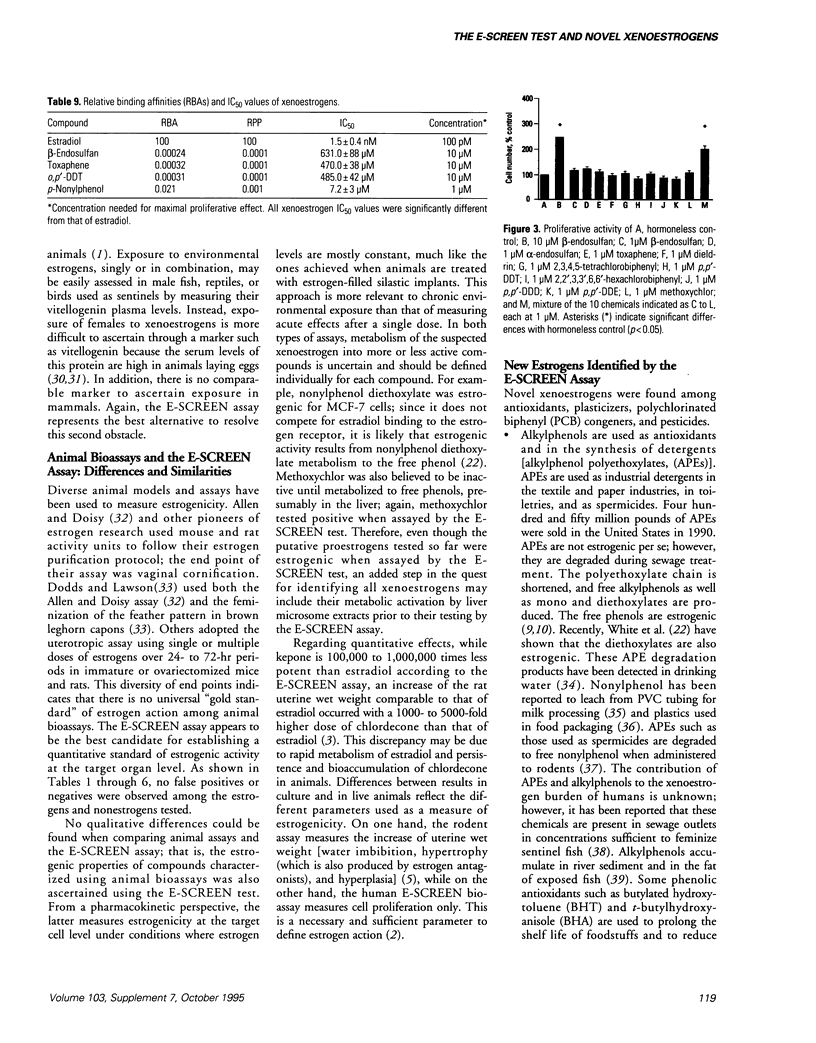
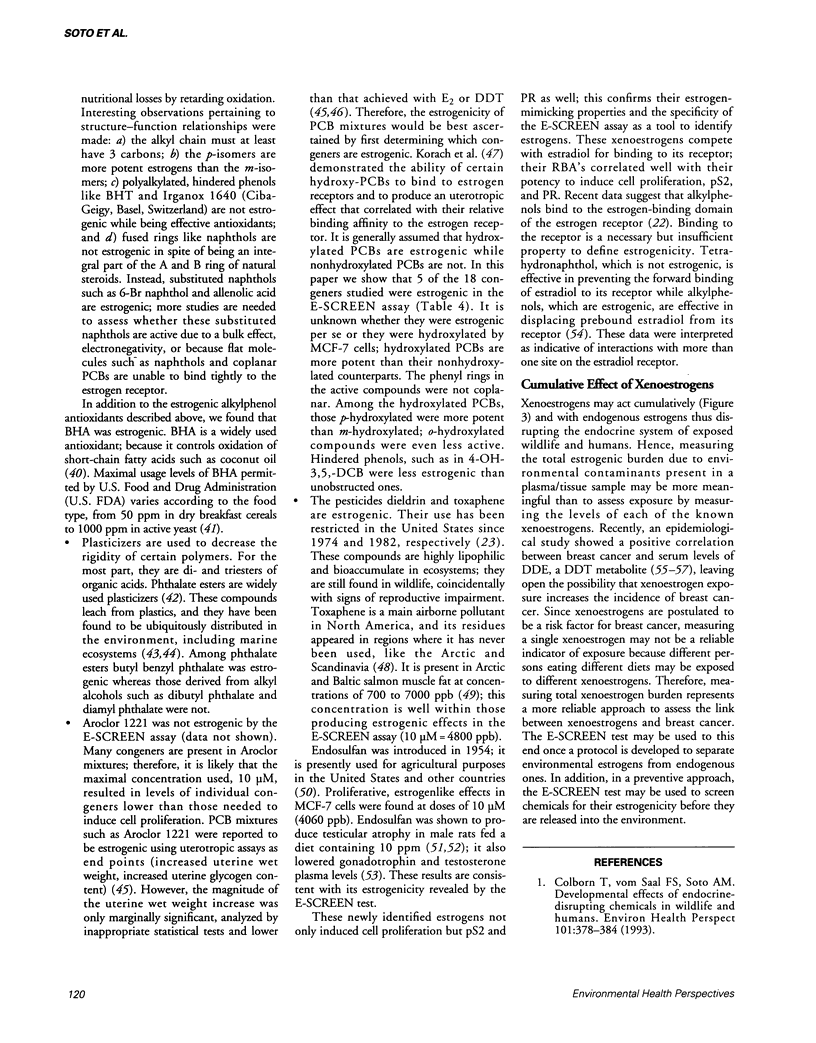
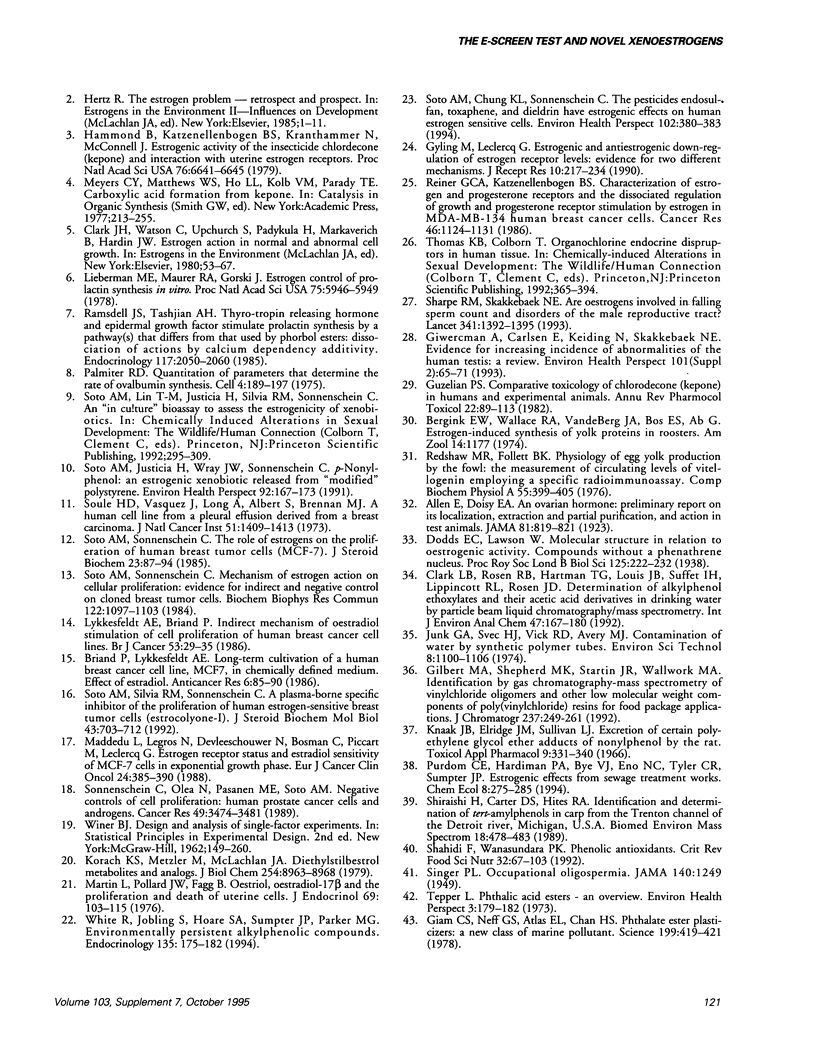
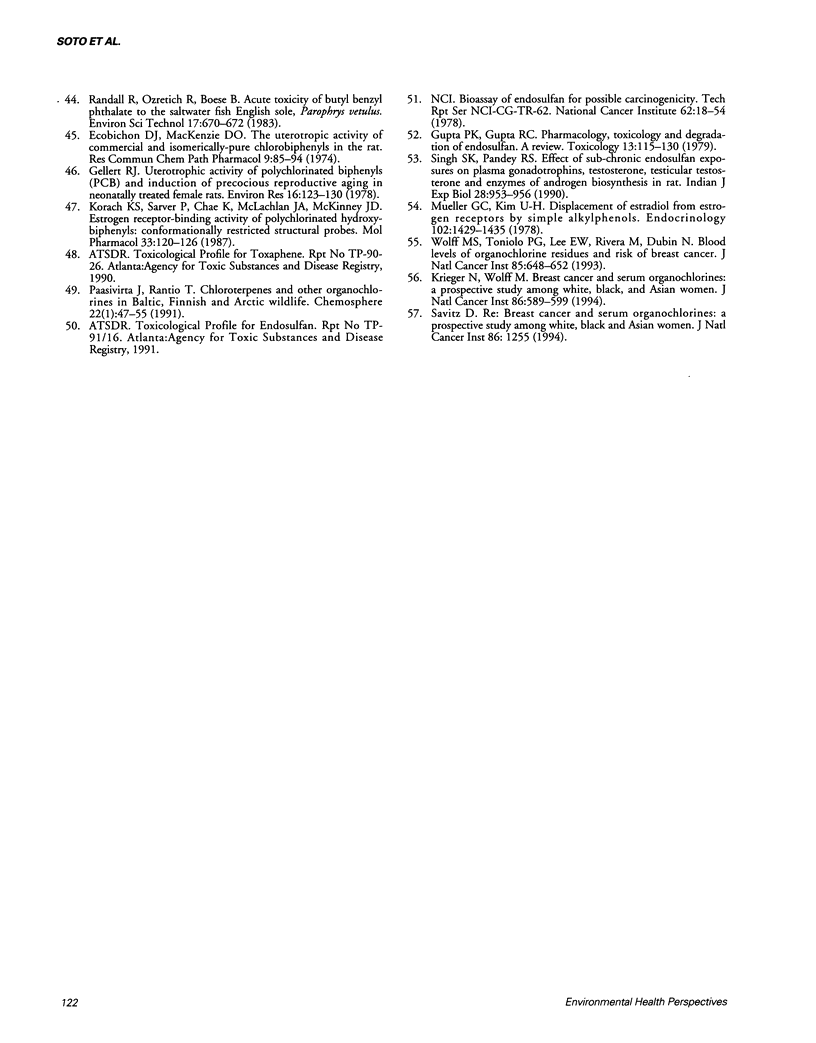
Selected References
These references are in PubMed. This may not be the complete list of references from this article.
- Briand P., Lykkesfeldt A. E. Long-term cultivation of a human breast cancer cell line, MCF-7, in a chemically defined medium. Effect of estradiol. Anticancer Res. 1986 Jan-Feb;6(1):85–90. [PubMed] [Google Scholar]
- Colborn T., vom Saal F. S., Soto A. M. Developmental effects of endocrine-disrupting chemicals in wildlife and humans. Environ Health Perspect. 1993 Oct;101(5):378–384. doi: 10.1289/ehp.93101378. [DOI] [PMC free article] [PubMed] [Google Scholar]
- Ecobichon D. J., MacKenzie D. O. The uterotropic activity of commercial and isomerically-pure chlorobiphenyls in the rat. Res Commun Chem Pathol Pharmacol. 1974 Sep;9(1):85–95. [PubMed] [Google Scholar]
- Gellert R. J. Uterotrophic activity of polychlorinated biphenyls (PCB) and induction of precocious reproductive aging in neonatally treated female rats. Environ Res. 1978 Jul;16(1-3):123–130. doi: 10.1016/0013-9351(78)90149-4. [DOI] [PubMed] [Google Scholar]
- Giam C. S., Chan H. S., Neff G. S., Atlas E. L. Phthalate ester plasticizers: a new class of marine pollutant. Science. 1978 Jan 27;199(4327):419–421. [PubMed] [Google Scholar]
- Giwercman A., Carlsen E., Keiding N., Skakkebaek N. E. Evidence for increasing incidence of abnormalities of the human testis: a review. Environ Health Perspect. 1993 Jul;101 (Suppl 2):65–71. doi: 10.1289/ehp.93101s265. [DOI] [PMC free article] [PubMed] [Google Scholar]
- Gupta P. K., Gupta R. C. Pharmacology, toxicology and degradation of endosulfan A review. Toxicology. 1979 Jun-Jul;13(2):115–130. [PubMed] [Google Scholar]
- Guzelian P. S. Comparative toxicology of chlordecone (Kepone) in humans and experimental animals. Annu Rev Pharmacol Toxicol. 1982;22:89–113. doi: 10.1146/annurev.pa.22.040182.000513. [DOI] [PubMed] [Google Scholar]
- Gyling M., Leclercq G., Heuson J. C. Estrogenic and antiestrogenic down-regulation of estrogen receptor levels: evidence for two different mechanisms. J Recept Res. 1990;10(5-6):217–234. doi: 10.3109/10799899009064667. [DOI] [PubMed] [Google Scholar]
- Hammond B., Katzenellenbogen B. S., Krauthammer N., McConnell J. Estrogenic activity of the insecticide chlordecone (Kepone) and interaction with uterine estrogen receptors. Proc Natl Acad Sci U S A. 1979 Dec;76(12):6641–6645. doi: 10.1073/pnas.76.12.6641. [DOI] [PMC free article] [PubMed] [Google Scholar]
- Knaak J. B., Eldridge J. M., Sullivan L. J. Excretion of certain polyethylene glycol ether adducts of nonylphenol by the rat. Toxicol Appl Pharmacol. 1966 Sep;9(2):331–340. doi: 10.1016/0041-008x(66)90129-3. [DOI] [PubMed] [Google Scholar]
- Korach K. S., Metzler M., McLachlan J. A. Diethylstilbestrol metabolites and analogs. New probes for the study of hormone action. J Biol Chem. 1979 Sep 25;254(18):8963–8968. [PubMed] [Google Scholar]
- Korach K. S., Sarver P., Chae K., McLachlan J. A., McKinney J. D. Estrogen receptor-binding activity of polychlorinated hydroxybiphenyls: conformationally restricted structural probes. Mol Pharmacol. 1988 Jan;33(1):120–126. [PubMed] [Google Scholar]
- Krieger N., Wolff M. S., Hiatt R. A., Rivera M., Vogelman J., Orentreich N. Breast cancer and serum organochlorines: a prospective study among white, black, and Asian women. J Natl Cancer Inst. 1994 Apr 20;86(8):589–599. doi: 10.1093/jnci/86.8.589. [DOI] [PubMed] [Google Scholar]
- Lieberman M. E., Maurer R. A., Gorski J. Estrogen control of prolactin synthesis in vitro. Proc Natl Acad Sci U S A. 1978 Dec;75(12):5946–5949. doi: 10.1073/pnas.75.12.5946. [DOI] [PMC free article] [PubMed] [Google Scholar]
- Lykkesfeldt A. E., Briand P. Indirect mechanism of oestradiol stimulation of cell proliferation of human breast cancer cell lines. Br J Cancer. 1986 Jan;53(1):29–35. doi: 10.1038/bjc.1986.5. [DOI] [PMC free article] [PubMed] [Google Scholar]
- Madeddu L., Legros N., Devleeschouwer N., Bosman C., Piccart M. J., LeClercq G. Estrogen receptor status and estradiol sensitivity of MCF-7 cells in exponential growth phase. Eur J Cancer Clin Oncol. 1988 Mar;24(3):385–390. doi: 10.1016/s0277-5379(98)90007-4. [DOI] [PubMed] [Google Scholar]
- Martin L., Pollard J. W., Fagg B. Oestriol, oestradiol-17beta and the proliferation and death of uterine cells. J Endocrinol. 1976 Apr;69(1):103–115. doi: 10.1677/joe.0.0690103. [DOI] [PubMed] [Google Scholar]
- Mueller G. C., Kim U. H. Displacement of estradiol from estrogen receptors by simple alkyl phenols. Endocrinology. 1978 May;102(5):1429–1435. doi: 10.1210/endo-102-5-1429. [DOI] [PubMed] [Google Scholar]
- Palmiter R. D. Quantitation of parameters that determine the rate of ovalbumin synthesis. Cell. 1975 Mar;4(3):189–189. doi: 10.1016/0092-8674(75)90167-1. [DOI] [PubMed] [Google Scholar]
- Ramsdell J. S., Tashjian A. H., Jr Thyrotropin-releasing hormone and epidermal growth factor stimulate prolactin synthesis by a pathway(s) that differs from that used by phorbol esters: dissociation of actions by calcium dependency and additivity. Endocrinology. 1985 Nov;117(5):2050–2060. doi: 10.1210/endo-117-5-2050. [DOI] [PubMed] [Google Scholar]
- Redshaw M. R., Follett B. K. Physiology of egg yolk production by the fowl: the measurement of circulating levels of vitellogenin employing a specific radioimmunoassay. Comp Biochem Physiol A Comp Physiol. 1976;55(4A):399–405. doi: 10.1016/0300-9629(76)90068-2. [DOI] [PubMed] [Google Scholar]
- Reiner G. C., Katzenellenbogen B. S. Characterization of estrogen and progesterone receptors and the dissociated regulation of growth and progesterone receptor stimulation by estrogen in MDA-MB-134 human breast cancer cells. Cancer Res. 1986 Mar;46(3):1124–1131. [PubMed] [Google Scholar]
- Savitz D. A. Re: Breast cancer and serum organochlorines: a prospective study among white, black, and Asian women. J Natl Cancer Inst. 1994 Aug 17;86(16):1255–1256. doi: 10.1093/jnci/86.16.1255. [DOI] [PubMed] [Google Scholar]
- Shahidi F., Wanasundara P. K. Phenolic antioxidants. Crit Rev Food Sci Nutr. 1992;32(1):67–103. doi: 10.1080/10408399209527581. [DOI] [PubMed] [Google Scholar]
- Sharpe R. M., Skakkebaek N. E. Are oestrogens involved in falling sperm counts and disorders of the male reproductive tract? Lancet. 1993 May 29;341(8857):1392–1395. doi: 10.1016/0140-6736(93)90953-e. [DOI] [PubMed] [Google Scholar]
- Shiraishi H., Carter D. S., Hites R. A. Identification and determination of tert-alkylphenols in carp from the Trenton Channel of the Detroit River, Michigan, USA. Biomed Environ Mass Spectrom. 1989 Jul;18(7):478–483. doi: 10.1002/bms.1200180706. [DOI] [PubMed] [Google Scholar]
- Singh S. K., Pandey R. S. Effect of sub-chronic endosulfan exposures on plasma gonadotrophins, testosterone, testicular testosterone and enzymes of androgen biosynthesis in rat. Indian J Exp Biol. 1990 Oct;28(10):953–956. [PubMed] [Google Scholar]
- Sonnenschein C., Olea N., Pasanen M. E., Soto A. M. Negative controls of cell proliferation: human prostate cancer cells and androgens. Cancer Res. 1989 Jul 1;49(13):3474–3481. [PubMed] [Google Scholar]
- Soto A. M., Chung K. L., Sonnenschein C. The pesticides endosulfan, toxaphene, and dieldrin have estrogenic effects on human estrogen-sensitive cells. Environ Health Perspect. 1994 Apr;102(4):380–383. doi: 10.1289/ehp.94102380. [DOI] [PMC free article] [PubMed] [Google Scholar]
- Soto A. M., Justicia H., Wray J. W., Sonnenschein C. p-Nonyl-phenol: an estrogenic xenobiotic released from "modified" polystyrene. Environ Health Perspect. 1991 May;92:167–173. doi: 10.1289/ehp.9192167. [DOI] [PMC free article] [PubMed] [Google Scholar]
- Soto A. M., Silvia R. M., Sonnenschein C. A plasma-borne specific inhibitor of the proliferation of human estrogen-sensitive breast tumor cells (estrocolyone-I). J Steroid Biochem Mol Biol. 1992 Dec;43(7):703–712. doi: 10.1016/0960-0760(92)90296-u. [DOI] [PubMed] [Google Scholar]
- Soto A. M., Sonnenschein C. Mechanism of estrogen action on cellular proliferation: evidence for indirect and negative control on cloned breast tumor cells. Biochem Biophys Res Commun. 1984 Aug 16;122(3):1097–1103. doi: 10.1016/0006-291x(84)91204-x. [DOI] [PubMed] [Google Scholar]
- Soto A. M., Sonnenschein C. The role of estrogens on the proliferation of human breast tumor cells (MCF-7). J Steroid Biochem. 1985 Jul;23(1):87–94. doi: 10.1016/0022-4731(85)90265-1. [DOI] [PubMed] [Google Scholar]
- Soule H. D., Vazguez J., Long A., Albert S., Brennan M. A human cell line from a pleural effusion derived from a breast carcinoma. J Natl Cancer Inst. 1973 Nov;51(5):1409–1416. doi: 10.1093/jnci/51.5.1409. [DOI] [PubMed] [Google Scholar]
- Tepper L. B. Phthalic acid esters--an overview. Environ Health Perspect. 1973 Jan;3:179–182. doi: 10.1289/ehp.7303179. [DOI] [PMC free article] [PubMed] [Google Scholar]
- White R., Jobling S., Hoare S. A., Sumpter J. P., Parker M. G. Environmentally persistent alkylphenolic compounds are estrogenic. Endocrinology. 1994 Jul;135(1):175–182. doi: 10.1210/endo.135.1.8013351. [DOI] [PubMed] [Google Scholar]
- Wolff M. S., Toniolo P. G., Lee E. W., Rivera M., Dubin N. Blood levels of organochlorine residues and risk of breast cancer. J Natl Cancer Inst. 1993 Apr 21;85(8):648–652. doi: 10.1093/jnci/85.8.648. [DOI] [PubMed] [Google Scholar]


